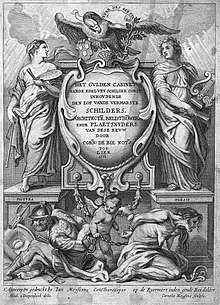
Joachim von Sandrart was a German Baroque art-historian and painter, active in Amsterdam during the Dutch Golden Age. He is most significant for his collection of biographies of Dutch and German artists the Teutsche Academie, published between 1675 and 1680.

Karel van Mander (I) or Carel van Mander I (May 1548 – 2 September 1606) was a Flemish painter, poet, art historian and art theoretician, who established himself in the Dutch Republic in the latter part of his life. He is mainly remembered as a biographer of Early Netherlandish painters and Northern Renaissance artists in his Schilder-boeck. As an artist and art theoretician he played a significant role in the spread and development of Northern Mannerism in the Dutch Republic.

Hendrick Jansz ter Brugghen was a Dutch painter of genre scenes and religious subjects. He was one of the Dutch followers of Caravaggio – the so-called Utrecht Caravaggisti. Along with Gerrit van Hondhorst and Dirck van Baburen, Ter Brugghen was one of the most important Dutch painters to have been influenced by Caravaggio.
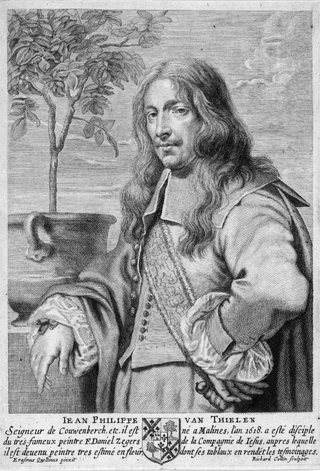
Jan Philip van Thielen or Jan Philips van Thielen was a Flemish painter who specialized in flower pieces and garland paintings. He was a regular collaborator with leading Flemish and Dutch figure painters of his time. Van Thielen was the most popular flower painter in Flanders and his patrons included Diego Felipez de Guzmán, 1st Marquis of Leganés and Leopold Wilhelm of Austria, the art-loving governor of the Southern Netherlands.

Cornelis de Bie was a Flemish rederijker, poet, jurist and minor politician from Lier. He is the author of about 64 works, mostly comedies. He is known internationally today for his biographical sketches of Flemish and Dutch painters in his Het Gulden Cabinet der Edel Vry Schilderconst, first printed in 1662.

Pieter Verbrugghen I was a Flemish sculptor from the Baroque.

Pieter Meert was a Flemish Baroque painter known for his portraits and genre paintings.

Adriaen or Adriaan van Stalbemt or Adriaen van Stalbempt was a Flemish painter and printmaker who is known for his landscapes with religious, mythological and allegorical scenes. He was also a gifted figure painter who was regularly invited to paint the staffage in compositions of fellow painters.

Andries van Eertvelt (1590–1652), was a Flemish painter, draughtsman and engraver who was one of the first Flemish artists to specialize in marine art. Several of his pupils also became prominent marine artists.

JoannesMeyssens was a Flemish Baroque painter, engraver, and print publisher.

Jan Baptist van Deynum, Dynen or Duinen (1620–1668), was a Flemish Baroque painter and a captain of the local civil guard in Antwerp. He is said to have painted portraits, genre subjects, history paintings and landscapes.

Leo van Heil, was a Flemish architect, painter and miniature painter mainly of flowers and insects. He is chiefly remembered for his designs of the Brigittines chapel and the tower of the Saint Nicholas Church, both in Brussels.
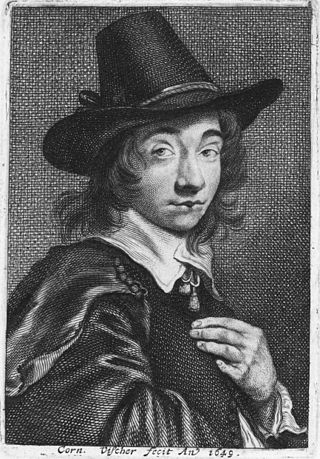
Cornelis Visscher, was a Dutch Golden Age engraver and the brother of Jan de Visscher and Lambert Visscher.
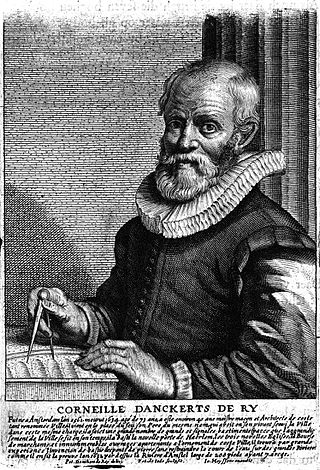
Cornelis Danckerts de Ry (1561–1634) was a Dutch Golden Age architect and sculptor.

Gysbrecht Thys or Gysbrechts Thys was a Flemish painter active in Antwerp known for his religious and mythological works as well as for his nudes. He also painted landscapes. Very few paintings have been attributed to the artist to date.

The German Academy of the Noble Arts of Architecture, Sculpture and Painting, or Teutsche Academie, refers to a comprehensive dictionary of art by Joachim von Sandrart published in the late 17th century. The first version was published in 1675 and it included a compilation of artist biographies that were later accompanied by illustrations by Richard Collin for a 1683 Latin edition by Christianus Rhodius. The list of portrait illustrations follows and is in page order. Most of the biographies were translated into German from earlier work by Karel van Mander and Cornelis de Bie, but Sandrart had travelled extensively in Europe and added many original biographies of German-born artists to his list. The illustrated portraits of artists born before his time were mostly based on 17th-century engravings by Hieronymus Cock and Jan Meyssens, many of which had also been re-published in De Bie's Het Gulden Cabinet.

Antoon van der Does or Antoni van der Does was a Flemish engraver and print maker who was active in Antwerp. He is mainly known as a reproductive artist.

Franciscus van der Steen was a Flemish painter and engraver who was active in Vienna. He is now mainly known for his reproductive prints after master paintings and various publications containing portraits of prominent persons. No known paintings are currently attributed to him.
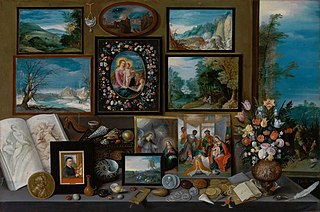
A Cabinet of Curiosities is a 1619 oil on panel painting of a cabinet of curiosities by the Flemish painter Frans Francken the Younger. It is now in the Royal Museum of Fine Arts, Antwerp, which bought it in 1903 from the Antwerp-based art dealer Joseph Hallyn.
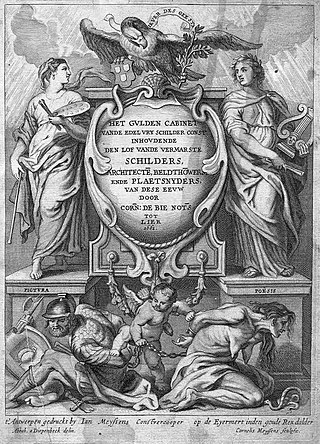
Cornelis Meyssens or Cornelis Meijssens was a Flemish engraver and printmaker, known for his reproductive prints after famous painters and portraits. He trained in his native Antwerp and later moved to Vienna where he worked for the remainder of his life.
